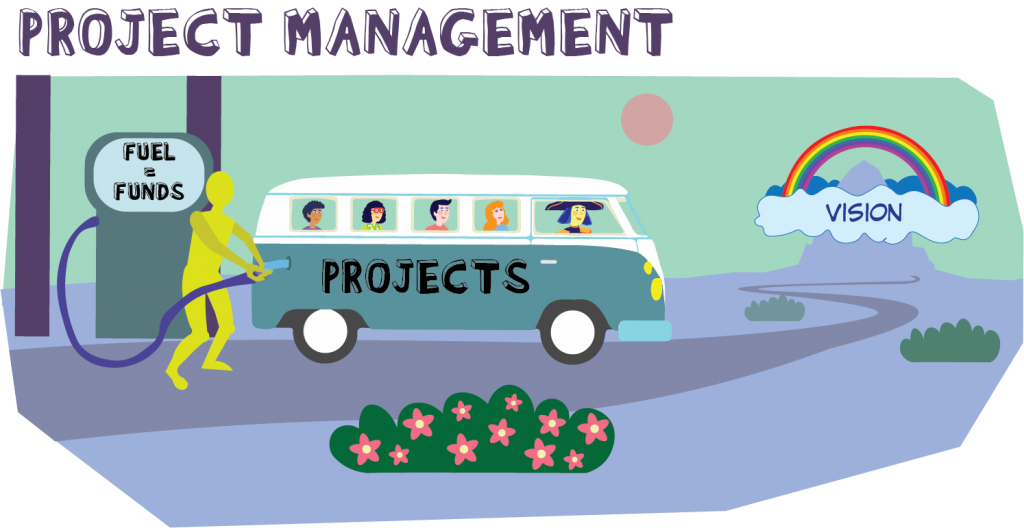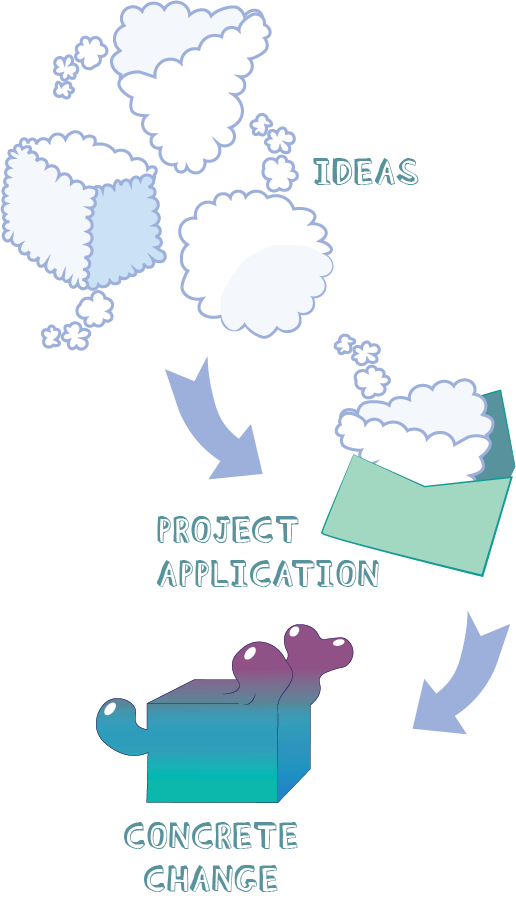
Although on a first sight it may look that project management is something completely different from running an NGO, in our world projects are key activity in reaching vision of our organization. It’s a main tool of how we are going to come from CURRENT STATE to DESIRED FUTURE STATE. Therefore, projects and activities we are implementing are vehicles on our road of changing our community. But if we enter into wrong vehicle or bus, we might side slide from the planned path.
Our projects need to align with mission and vision of our organization. Only that way we will keep vehicle on the right path of change.
First issue is often solved by your organizational strategic plan about which we have talked in one of the previous chapters of this toolkit. Simply by checking if your project or idea are in line with your strategic goals.
⛽ However, there is one bigger problem. What if your vehicle run out of fuel?!
By fuel we mean on funding of your ideas that should lead you toward your vision. Therefore, it is necessary to transform your ideas into successful projects that will gain support from donors. Having that in mind, Internal MakeOver of your organization also includes rethinking of the way how you and your team are managing projects. This toolkit is going to provide you with step-by-step approach of transforming ideas into project applications, and project applications into concrete changes in your society. You will have a chance to dig deeper into:
- The methodology of transforming ideas into applications
- Advice on how to run projects and most important things you need to take care about
- Financial management
- Evaluation and Follow up.
⛽ With the expertise provided, we intend to help you to do not ever run out of fuel.

EVERYTHING STARTS WITH AN IDEA
Writing your project application starts with a planning process. The planning process is simple and intuitive. Anyone makes plans to a certain extent on a daily basis. You are probably not even aware that for planning of weekly grocery shopping or organising of a celebration you use elements of a project proposal, in fact you are answering questions such as: WHY, WHAT, HOW, HOW MUCH. On top of that, at the end of the activity (grocery shopping or a party), you are either satisfied with the result or not, so unconscientiously you set some criteria according to which you evaluate the level of your success, which is also an integral part of a project proposal – evaluation plan. Off course, although the planning process is essentially simple and generally known, preparation of a well-written project proposal requires some other skills and knowledge. The first step towards this goal (knowledge) you can find in the following pages, while other (skills) are usually acquired through practical work.
So, let’s talk about knowledge. It all starts with an idea to change something in your environment. Those desired changes in your community you have already targeted when doing a strategic planning of your organization.
There are few steps that will help you develop good ideas.
- Target people who are important for your organization in organizing activities and writing applications in certain focus area
- Invite them on a meeting and provide them beforehand with the purpose of the meeting and if possible, some material on the topic
- Prepare a list of questions which can help you boost discussion about certain issue
- Open brainstorming session of how to tackle targeted issue – KEEP IN MIND THAT YOUR SOLUTION NEED TO GO IN LINE WITH YOUR STRATEGY
- Consider importance of involving target group and final beneficiaries into planning process. They can provide you with a valuable knowledge and experience
- Key in this process in answer on most important question – WHY you want to implement this project/idea? By formulating and analyzing the answer to the question WHY, not only will you develop a line of reasoning that you can use to explain to your partners and also to potential donors the importance of your project as a response to some needs identified in the society, but also set the basis for creation of a complete project proposal, as you will see below.
The planning methodology exposed in this toolkit is not the only one that can transform your ideas into an action plan, however, it is very efficient and often used because of its simplicity and a logical succession of steps.

Each donor has an individual application form and it is possible that you will find somewhat different terminology or structure of a plan in regards to the one that we recommend, but if you have a clear idea of what you intend to achieve with the project, you should have no difficulties regrading filling in of various application forms.
By the end of this process you will be able to answer following questions:
- Is it in tune with our values?
- Is it in tune with our mission?
- What is the most efficient way for execution? Do we have resources for it? Can we assure the resources?
- Clarity / Understandability for young people? Is there a need for it?
- Do we really wanna do this?
